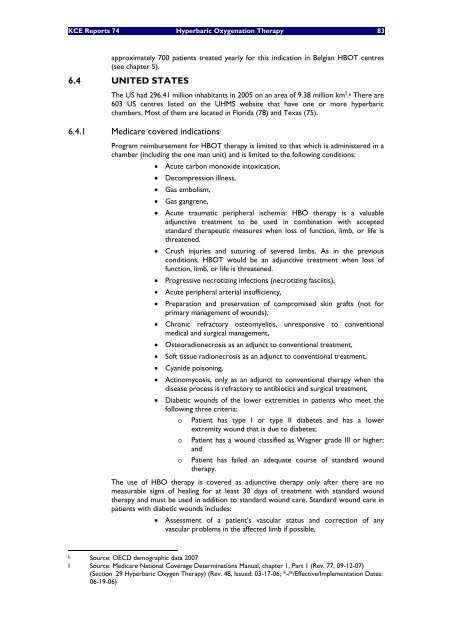Hyperbare Zuurstoftherapie: Rapid Assessment - KCE
Hyperbare Zuurstoftherapie: Rapid Assessment - KCE
Hyperbare Zuurstoftherapie: Rapid Assessment - KCE
Create successful ePaper yourself
Turn your PDF publications into a flip-book with our unique Google optimized e-Paper software.
<strong>KCE</strong> Reports 74 Hyperbaric Oxygenation Therapy 83<br />
approximately 700 patients treated yearly for this indication in Belgian HBOT centres<br />
(see chapter 5).<br />
6.4 UNITED STATES<br />
The US had 296.41 million inhabitants in 2005 on an area of 9.38 million km 2 . k There are<br />
603 US centres listed on the UHMS website that have one or more hyperbaric<br />
chambers. Most of them are located in Florida (78) and Texas (75).<br />
6.4.1 Medicare covered indications l<br />
Program reimbursement for HBOT therapy is limited to that which is administered in a<br />
chamber (including the one man unit) and is limited to the following conditions:<br />
• Acute carbon monoxide intoxication,<br />
• Decompression illness,<br />
• Gas embolism,<br />
• Gas gangrene,<br />
• Acute traumatic peripheral ischemia: HBO therapy is a valuable<br />
adjunctive treatment to be used in combination with accepted<br />
standard therapeutic measures when loss of function, limb, or life is<br />
threatened.<br />
• Crush injuries and suturing of severed limbs. As in the previous<br />
conditions, HBOT would be an adjunctive treatment when loss of<br />
function, limb, or life is threatened.<br />
• Progressive necrotizing infections (necrotizing fasciitis),<br />
• Acute peripheral arterial insufficiency,<br />
• Preparation and preservation of compromised skin grafts (not for<br />
primary management of wounds),<br />
• Chronic refractory osteomyelitis, unresponsive to conventional<br />
medical and surgical management,<br />
• Osteoradionecrosis as an adjunct to conventional treatment,<br />
• Soft tissue radionecrosis as an adjunct to conventional treatment,<br />
• Cyanide poisoning,<br />
• Actinomycosis, only as an adjunct to conventional therapy when the<br />
disease process is refractory to antibiotics and surgical treatment,<br />
• Diabetic wounds of the lower extremities in patients who meet the<br />
following three criteria:<br />
o Patient has type I or type II diabetes and has a lower<br />
extremity wound that is due to diabetes;<br />
o Patient has a wound classified as Wagner grade III or higher;<br />
and<br />
o Patient has failed an adequate course of standard wound<br />
therapy.<br />
The use of HBO therapy is covered as adjunctive therapy only after there are no<br />
measurable signs of healing for at least 30 days of treatment with standard wound<br />
therapy and must be used in addition to standard wound care. Standard wound care in<br />
patients with diabetic wounds includes:<br />
• <strong>Assessment</strong> of a patient’s vascular status and correction of any<br />
vascular problems in the affected limb if possible,<br />
k Source: OECD demographic data 2007<br />
l Source: Medicare National Coverage Determinations Manual, chapter 1, Part 1 (Rev. 77, 09-12-07)<br />
(Section .29 Hyperbaric Oxygen Therapy) (Rev. 48, Issued: 03-17-06; *-/*/Effective/Implementation Dates:<br />
06-19-06)

















